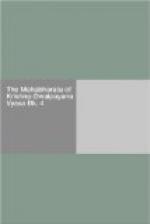[43] Indian insects of a particular kind.
[44] Most editions read chapas
which is evidently wrong. The
correct reading is avapas,
meaning quiver. The Burdwan Pandits
give this latter reading.
[45] Some read chandrargha-darsanas.
The correct reading is
chandrardha-darsanas.
[46] Most editions read hema-punkha
and silasita in the
instrumental plural; the correct
reading is their nominative
plural forms.
[47] Sayaka means here,
as explained by Nilakantha, a sword,
and not a shaft.
SECTION XLIII
“Vrihannala said, ’That about which thou hath first enquired is Arjuna’s bow, of world-wide fame, called Gandiva, capable of devastating hostile hosts. Embellished with gold, this Gandiva, the highest and largest of all weapons belonged to Arjuna. Alone equal unto a hundred thousand weapons, and always capable of extending the confines of kingdoms, it is with this that Partha vanquisheth in battle both men and celestials. Worshipped ever by the gods, the Danavas and the Gandharvas and variegated with excellent colours, this large and smooth bow is without a knot or stain anywhere. Shiva held it first for a thousand years. Afterwards Prajapati held it for five hundred and three years. After that Sakra, for five and eighty years. And then Soma held it for five hundred years. And after that Varuna held it for a hundred years. And finally Partha, surnamed Swetavahana,[48] hath held it for five and sixty years.[49] Endued with great energy and of high celestial origin, this is the best of all bows. Adored among gods and men, it hath a handsome form. Partha obtained this beautiful bow from Varuna. This other bow of handsome sides and golden handle is Bhima’s with which that son of Pritha, that chastiser of foes, had conquered the whole of the eastern regions. This other excellent bow of beautiful shape, adorned with images of Indragopakas, belongeth, O Virata’s son, to king Yudhishthira. This other weapon with golden suns of blazing splendour shedding a dazzling effulgence around, belongeth to Nakula. And this bow adorned with golden images of insects and set also with gems and stones, belongeth to that son of Madri




